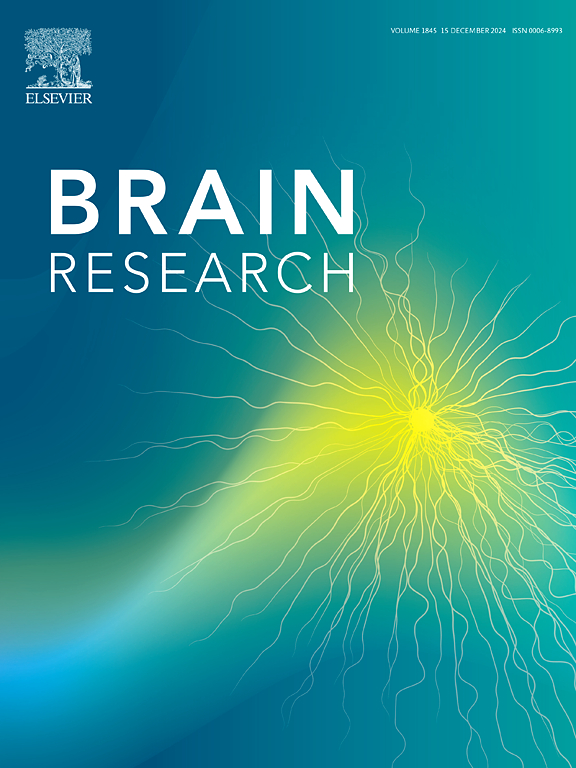Cortical activity during balance and walking tasks in stroke patients: Functional near-infrared spectroscopy neuroimaging research
IF 2.6
4区 医学
Q3 NEUROSCIENCES
引用次数: 0
Abstract
Background
Stroke survivors frequently suffer from balance and gait impairments, yet the cortical mechanisms underlying these functions remain unclear. This study addresses this gap by utilizing portable functional near-infrared spectroscopy (fNIRS) to map task-specific neuroplasticity.
Objectives
We aimed to (1) compare cortical activation patterns during balance and walking tasks, (2) analyze functional connectivity (FC) and lateralization differences, and (3) explore correlations between neuroimaging metrics and clinical outcomes.
Methods
In this cross-sectional study, 31 stroke patients (60 ± 11.90 years; 29 % female) completed Tetrax balance training or AlterG treadmill walking. fNIRS measured hemodynamic responses in prefrontal, premotor, motor, somatosensory, and occipital cortices. Wavelet amplitude (WA) quantified activation; wavelet phase coherence (WPCO) assessed FC.
Results
Bilateral premotor cortex (PMC) and contralateral primary somatosensory cortex (S1) activation significantly increased during walking (P < 0.001).
FC strength increased between ipsilateral occipital cortex (iOC) and contralateral S1/M1 during walking (P < 0.05) but decreased in balance tasks.
Negative correlation emerged between contralateral PMC activation and Fugl-Meyer scores during balance (r = −0.537, P = 0.039), while activities of daily living (ADL) scores positively correlated with motor/occipital activation during walking (r = 0.53–0.87, P < 0.035).
No lateralization asymmetry was observed (P > 0.05).
Conclusions
Enhanced S1/occipital activation highlights critical roles of sensory-visual integration in post-stroke locomotion. Contralateral recruitment compensates for ipsilateral deficits during challenging tasks, providing neurophysiological insights for targeted rehabilitation.

脑卒中患者在平衡和行走任务中的皮层活动:功能性近红外光谱神经成像研究
中风幸存者经常遭受平衡和步态障碍,然而这些功能背后的皮质机制尚不清楚。本研究通过使用便携式功能近红外光谱(fNIRS)来绘制任务特异性神经可塑性来解决这一空白。我们的目的是(1)比较平衡和行走任务时的皮层激活模式,(2)分析功能连接(FC)和侧化差异,(3)探索神经影像学指标与临床结果之间的相关性。方法在横断面研究中,31例脑卒中患者(60±11.90岁;29%(女性)完成了四边形平衡训练或AlterG跑步机步行。fNIRS测量了前额叶、前运动、运动、体感觉和枕叶皮层的血流动力学反应。小波振幅(WA)量化激活;小波相位相干性(WPCO)评价了FC。结果行走时双侧运动前皮质(PMC)和对侧初级体感皮质(S1)激活显著增加(P <;0.001)。行走时同侧枕皮质(iOC)和对侧S1/M1间FC强度增加(P <;0.05),但平衡能力下降。对侧PMC激活与平衡时Fugl-Meyer评分呈负相关(r = - 0.537, P = 0.039),而日常生活活动(ADL)评分与步行时运动/枕部激活呈正相关(r = 0.53-0.87, P <;0.035)。未观察到侧化不对称(P >;0.05)。结论S1/枕部激活的增强突出了感觉-视觉整合在脑卒中后运动中的重要作用。在具有挑战性的任务中,对侧招募补偿了同侧的缺陷,为有针对性的康复提供了神经生理学的见解。
本文章由计算机程序翻译,如有差异,请以英文原文为准。
求助全文
约1分钟内获得全文
求助全文
来源期刊

Brain Research
医学-神经科学
CiteScore
5.90
自引率
3.40%
发文量
268
审稿时长
47 days
期刊介绍:
An international multidisciplinary journal devoted to fundamental research in the brain sciences.
Brain Research publishes papers reporting interdisciplinary investigations of nervous system structure and function that are of general interest to the international community of neuroscientists. As is evident from the journals name, its scope is broad, ranging from cellular and molecular studies through systems neuroscience, cognition and disease. Invited reviews are also published; suggestions for and inquiries about potential reviews are welcomed.
With the appearance of the final issue of the 2011 subscription, Vol. 67/1-2 (24 June 2011), Brain Research Reviews has ceased publication as a distinct journal separate from Brain Research. Review articles accepted for Brain Research are now published in that journal.
 求助内容:
求助内容: 应助结果提醒方式:
应助结果提醒方式:


